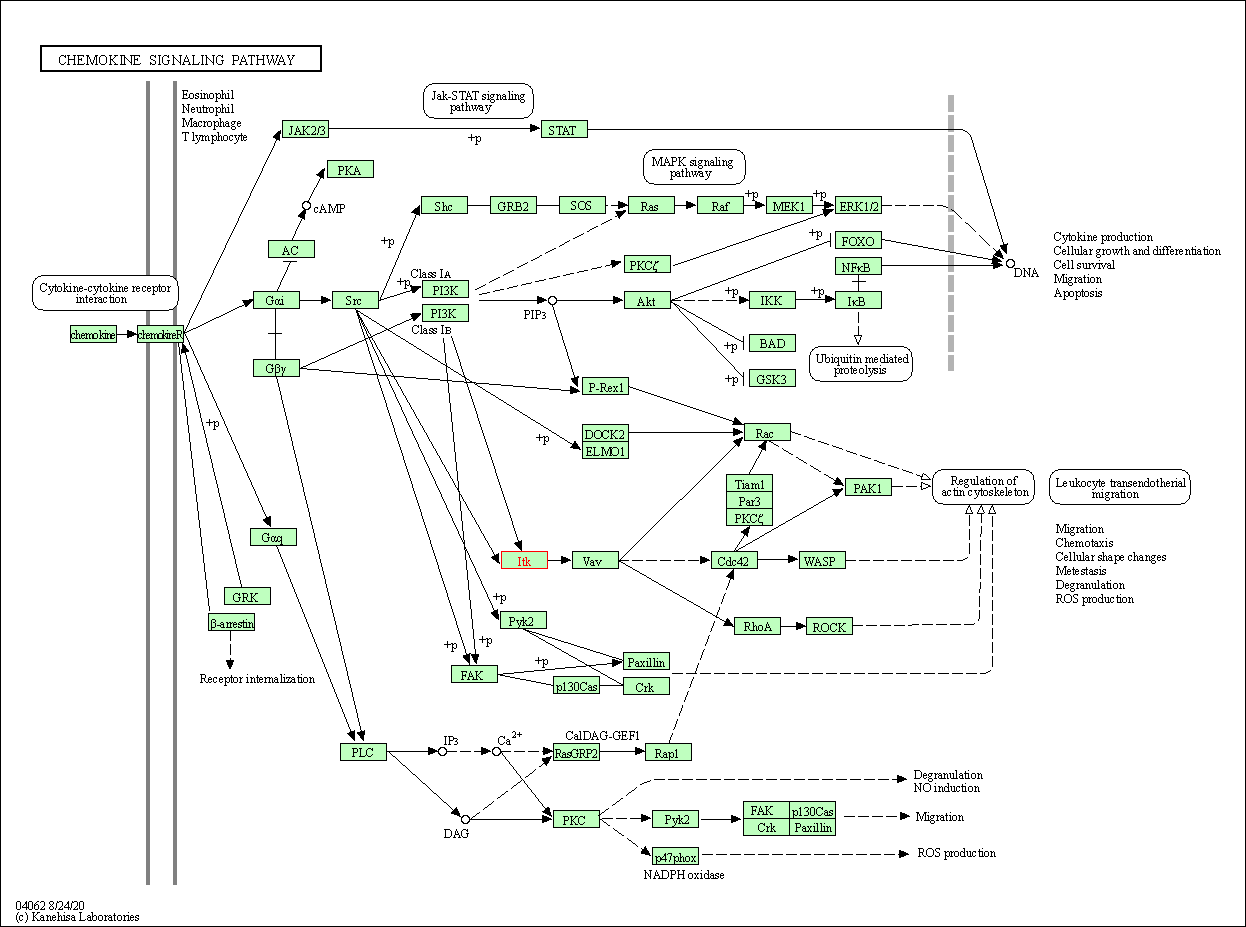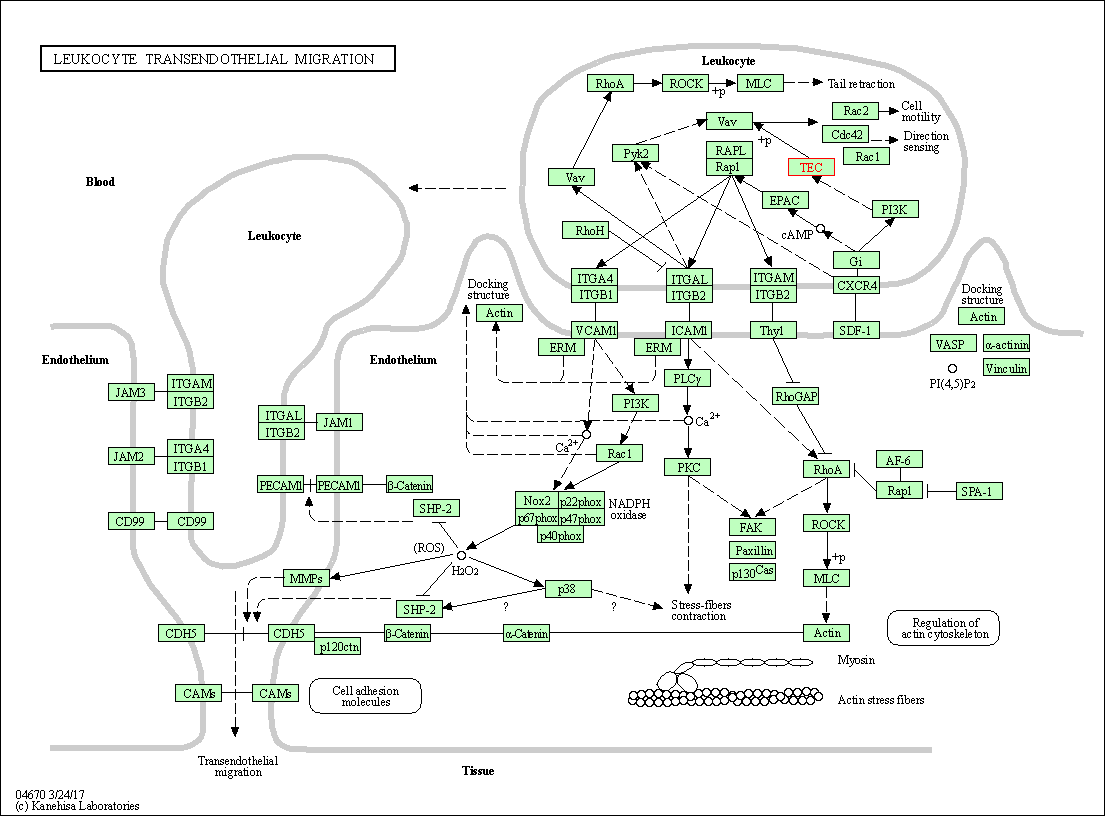Target Information
| Target General Information | Top | |||||
|---|---|---|---|---|---|---|
| Target ID |
T91761
(Former ID: TTDR00858)
|
|||||
| Target Name |
T-cell-specific kinase (ITK)
|
|||||
| Synonyms |
Tyrosine kinase ITK; Inducible T cell kinase; EMT
Click to Show/Hide
|
|||||
| Gene Name |
ITK
|
|||||
| Target Type |
Clinical trial target
|
[1] | ||||
| Disease | [+] 3 Target-related Diseases | + | ||||
| 1 | Psoriasis [ICD-11: EA90] | |||||
| 2 | Allergic/hypersensitivity disorder [ICD-11: 4A80-4A8Z] | |||||
| 3 | Mature T-cell lymphoma [ICD-11: 2A90] | |||||
| Function |
Regulates the development, function and differentiation of conventional T-cells and nonconventional NKT-cells. When antigen presenting cells (APC) activate T-cell receptor (TCR), a series of phosphorylation lead to the recruitment of ITK to the cell membrane, in the vicinity of the stimulated TCR receptor, where it is phosphorylated by LCK. Phosphorylation leads to ITK autophosphorylation and full activation. Once activated, phosphorylates PLCG1, leading to the activation of this lipase and subsequent cleavage of its substrates. In turn, the endoplasmic reticulum releases calcium in the cytoplasm and the nuclear activator of activated T-cells (NFAT) translocates into the nucleus to perform its transcriptional duty. Phosphorylates 2 essential adapter proteins: the linker for activation of T-cells/LAT protein and LCP2. Then, a large number of signaling molecules such as VAV1 are recruited and ultimately lead to lymphokine production, T-cell proliferation and differentiation. Phosphorylates TBX21 at 'Tyr-530' and mediates its interaction with GATA3. Tyrosine kinase that plays an essential role in regulation of the adaptive immune response.
Click to Show/Hide
|
|||||
| BioChemical Class |
Kinase
|
|||||
| UniProt ID | ||||||
| EC Number |
EC 2.7.10.2
|
|||||
| Sequence |
MNNFILLEEQLIKKSQQKRRTSPSNFKVRFFVLTKASLAYFEDRHGKKRTLKGSIELSRI
KCVEIVKSDISIPCHYKYPFQVVHDNYLLYVFAPDRESRQRWVLALKEETRNNNSLVPKY HPNFWMDGKWRCCSQLEKLATGCAQYDPTKNASKKPLPPTPEDNRRPLWEPEETVVIALY DYQTNDPQELALRRNEEYCLLDSSEIHWWRVQDRNGHEGYVPSSYLVEKSPNNLETYEWY NKSISRDKAEKLLLDTGKEGAFMVRDSRTAGTYTVSVFTKAVVSENNPCIKHYHIKETND NPKRYYVAEKYVFDSIPLLINYHQHNGGGLVTRLRYPVCFGRQKAPVTAGLRYGKWVIDP SELTFVQEIGSGQFGLVHLGYWLNKDKVAIKTIREGAMSEEDFIEEAEVMMKLSHPKLVQ LYGVCLEQAPICLVFEFMEHGCLSDYLRTQRGLFAAETLLGMCLDVCEGMAYLEEACVIH RDLAARNCLVGENQVIKVSDFGMTRFVLDDQYTSSTGTKFPVKWASPEVFSFSRYSSKSD VWSFGVLMWEVFSEGKIPYENRSNSEVVEDISTGFRLYKPRLASTHVYQIMNHCWKERPE DRPAFSRLLRQLAEIAESGL Click to Show/Hide
|
|||||
| 3D Structure | Click to Show 3D Structure of This Target | AlphaFold | ||||
| Drugs and Modes of Action | Top | |||||
|---|---|---|---|---|---|---|
| Clinical Trial Drug(s) | [+] 2 Clinical Trial Drugs | + | ||||
| 1 | JTE-051 | Drug Info | Phase 2 | Plaque psoriasis | [2] | |
| 2 | CPI-818 | Drug Info | Phase 1 | T-cell lymphoma | [3] | |
| Mode of Action | [+] 1 Modes of Action | + | ||||
| Inhibitor | [+] 6 Inhibitor drugs | + | ||||
| 1 | JTE-051 | Drug Info | [1] | |||
| 2 | CPI-818 | Drug Info | [4] | |||
| 3 | PMID27774824-Compound-Figure3Example7 | Drug Info | [5] | |||
| 4 | Pyrazolo[4,3-c]pyridine derivative 2 | Drug Info | [5] | |||
| 5 | BMS-488516 | Drug Info | [6], [7] | |||
| 6 | BMS-509744 | Drug Info | [6], [7] | |||
| Cell-based Target Expression Variations | Top | |||||
|---|---|---|---|---|---|---|
| Cell-based Target Expression Variations | ||||||
| Drug Binding Sites of Target | Top | |||||
|---|---|---|---|---|---|---|
| Ligand Name: Sunitinib | Ligand Info | |||||
| Structure Description | X-ray crystal structure of ITK complexed with sunitinib | PDB:3MIY | ||||
| Method | X-ray diffraction | Resolution | 1.67 Å | Mutation | Yes | [8] |
| PDB Sequence |
GSVIDPSELT
364 FVQEIGSGGL376 VHLGYWLNKD386 KVAIKTISEE401 DFIEEAEVMM411 KLSHPKLVQL 421 YGVCLEQAPI431 CLVFEFMEHG441 CLSDYLRTQR451 GLFAAETLLG461 MCLDVCEGMA 471 YLEEASVIHR481 DLAARNCLVG491 ENQVIKVSDF501 PVKWASPEVF530 SFSRYSSKSD 540 VWSFGVLMWE550 VFSEGKIPYE560 NRSNSEVVED570 ISTGFRLYKP580 RLASTHVYQI 590 MNHCWKERPE600 DRPAFSRLLR610 QLAAIAASG
|
|||||
|
|
||||||
| Ligand Name: adenosine diphosphate | Ligand Info | |||||
| Structure Description | Crystal structure of ITK in complex with compound 9 [4-(carbamoylamino)-1-[7-(propan-2-yloxy)naphthalen-1-yl]-1H-pyrazole-3-carboxamide] and ADP | PDB:4M15 | ||||
| Method | X-ray diffraction | Resolution | 1.52 Å | Mutation | No | [9] |
| PDB Sequence |
KWVIDPSELT
364 FVQEIGSGQF374 GLVHLGYWLN384 KDKVAIKTIR394 EGAMSEEDFI404 EEAEVMMKLS 414 HPKLVQLYGV424 CLEQAPICLV434 FEFMEHGCLS444 DYLRTQRGLF454 AAETLLGMCL 464 DVCEGMAYLE474 EACVIHRDLA484 ARNCLVGENQ494 VIKVSDFGMT504 RFVLDDQYTS 514 STGTKFPVKW524 ASPEVFSFSR534 YSSKSDVWSF544 GVLMWEVFSE554 GKIPYENRSN 564 SEVVEDISTG574 FRLYKPRLAS584 THVYQIMNHC594 WRERPEDRPA604 FSRLLRQLAE 614 IAE
|
|||||
|
|
||||||
| Click to View More Binding Site Information of This Target with Different Ligands | ||||||
| Different Human System Profiles of Target | Top |
|---|---|
|
Human Similarity Proteins
of target is determined by comparing the sequence similarity of all human proteins with the target based on BLAST. The similarity proteins for a target are defined as the proteins with E-value < 0.005 and outside the protein families of the target.
A target that has fewer human similarity proteins outside its family is commonly regarded to possess a greater capacity to avoid undesired interactions and thus increase the possibility of finding successful drugs
(Brief Bioinform, 21: 649-662, 2020).
Human Tissue Distribution
of target is determined from a proteomics study that quantified more than 12,000 genes across 32 normal human tissues. Tissue Specificity (TS) score was used to define the enrichment of target across tissues.
The distribution of targets among different tissues or organs need to be taken into consideration when assessing the target druggability, as it is generally accepted that the wider the target distribution, the greater the concern over potential adverse effects
(Nat Rev Drug Discov, 20: 64-81, 2021).
Human Pathway Affiliation
of target is determined by the life-essential pathways provided on KEGG database. The target-affiliated pathways were defined based on the following two criteria (a) the pathways of the studied target should be life-essential for both healthy individuals and patients, and (b) the studied target should occupy an upstream position in the pathways and therefore had the ability to regulate biological function.
Targets involved in a fewer pathways have greater likelihood to be successfully developed, while those associated with more human pathways increase the chance of undesirable interferences with other human processes
(Pharmacol Rev, 58: 259-279, 2006).
Biological Network Descriptors
of target is determined based on a human protein-protein interactions (PPI) network consisting of 9,309 proteins and 52,713 PPIs, which were with a high confidence score of ≥ 0.95 collected from STRING database.
The network properties of targets based on protein-protein interactions (PPIs) have been widely adopted for the assessment of target’s druggability. Proteins with high node degree tend to have a high impact on network function through multiple interactions, while proteins with high betweenness centrality are regarded to be central for communication in interaction networks and regulate the flow of signaling information
(Front Pharmacol, 9, 1245, 2018;
Curr Opin Struct Biol. 44:134-142, 2017).
Human Similarity Proteins
Human Tissue Distribution
Human Pathway Affiliation
Biological Network Descriptors
|
|
|
Note:
If a protein has TS (tissue specficity) scores at least in one tissue >= 2.5, this protein is called tissue-enriched (including tissue-enriched-but-not-specific and tissue-specific). In the plots, the vertical lines are at thresholds 2.5 and 4.
|
| KEGG Pathway | Pathway ID | Affiliated Target | Pathway Map |
|---|---|---|---|
| Chemokine signaling pathway | hsa04062 | Affiliated Target |

|
| Class: Organismal Systems => Immune system | Pathway Hierarchy | ||
| T cell receptor signaling pathway | hsa04660 | Affiliated Target |

|
| Class: Organismal Systems => Immune system | Pathway Hierarchy | ||
| Leukocyte transendothelial migration | hsa04670 | Affiliated Target |

|
| Class: Organismal Systems => Immune system | Pathway Hierarchy | ||
| Degree | 16 | Degree centrality | 1.72E-03 | Betweenness centrality | 1.80E-05 |
|---|---|---|---|---|---|
| Closeness centrality | 2.26E-01 | Radiality | 1.40E+01 | Clustering coefficient | 6.75E-01 |
| Neighborhood connectivity | 4.29E+01 | Topological coefficient | 1.46E-01 | Eccentricity | 12 |
| Download | Click to Download the Full PPI Network of This Target | ||||
| Chemical Structure based Activity Landscape of Target | Top |
|---|---|
| Target Poor or Non Binders | Top | |||||
|---|---|---|---|---|---|---|
| Target Poor or Non Binders | ||||||
| Target Regulators | Top | |||||
|---|---|---|---|---|---|---|
| Target-regulating microRNAs | ||||||
| Target-interacting Proteins | ||||||
| Target Affiliated Biological Pathways | Top | |||||
|---|---|---|---|---|---|---|
| KEGG Pathway | [+] 3 KEGG Pathways | + | ||||
| 1 | Chemokine signaling pathway | |||||
| 2 | T cell receptor signaling pathway | |||||
| 3 | Leukocyte transendothelial migration | |||||
| NetPath Pathway | [+] 1 NetPath Pathways | + | ||||
| 1 | IL2 Signaling Pathway | |||||
| PID Pathway | [+] 4 PID Pathways | + | ||||
| 1 | Fc-epsilon receptor I signaling in mast cells | |||||
| 2 | TCR signaling in naï | |||||
| 3 | ||||||
| 4 | Class I PI3K signaling events | |||||
| Reactome | [+] 2 Reactome Pathways | + | ||||
| 1 | Generation of second messenger molecules | |||||
| 2 | FCERI mediated Ca+2 mobilization | |||||
| WikiPathways | [+] 3 WikiPathways | + | ||||
| 1 | TCR Signaling Pathway | |||||
| 2 | T-Cell Receptor and Co-stimulatory Signaling | |||||
| 3 | TCR signaling | |||||
| References | Top | |||||
|---|---|---|---|---|---|---|
| REF 1 | Characterisation of a K390R ITK Kinase Dead Transgenic Mouse - Implications for ITK as a Therapeutic Target. PLoS One. 2014; 9(9): e107490. | |||||
| REF 2 | Clinical pipeline report, company report or official report of the Pharmaceutical Research and Manufacturers of America (PhRMA) | |||||
| REF 3 | ClinicalTrials.gov (NCT03952078) A Dose Escalation Study Evaluating CPI-818 in Relapsed/Refractory T-Cell Lymphoma. U.S. National Institutes of Health. | |||||
| REF 4 | Clinical pipeline report, company report or official report of Corvus Pharmaceuticals. | |||||
| REF 5 | Inhibitors of JAK-family kinases: an update on the patent literature 2013-2015, part 1.Expert Opin Ther Pat. 2017 Feb;27(2):127-143. | |||||
| REF 6 | Treatment of depersonalization with serotonin reuptake blockers. J Clin Psychopharmacol. 1990 Jun;10(3):200-3. | |||||
| REF 7 | ITK inhibitors in inflammation and immune-mediated disorders. Curr Top Med Chem. 2009;9(8):690-703. | |||||
| REF 8 | Crystal structures of IL-2-inducible T cell kinase complexed with inhibitors: insights into rational drug design and activity regulation. Chem Biol Drug Des. 2010 Aug;76(2):154-63. | |||||
| REF 9 | Selectively targeting an inactive conformation of interleukin-2-inducible T-cell kinase by allosteric inhibitors. Biochem J. 2014 Jun 1;460(2):211-22. | |||||
If You Find Any Error in Data or Bug in Web Service, Please Kindly Report It to Dr. Zhou and Dr. Zhang.

